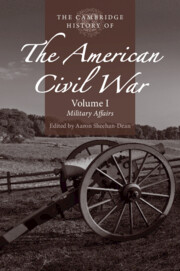Book contents
- The Cambridge History of the American Civil War
- The Cambridge History of the American Civil War
- The Cambridge History of the American Civil War
- Copyright page
- Contents
- Maps
- Contributors to Volume I
- Acknowledgments
- Note on the Text
- 1 Introduction: The Cambridge History of the American Civil War
- Part I Major Battles and Campaigns
- 2 The Battles of Virginia, 1861
- 3 The Battles of Tennessee, 1862
- 4 The Battles of the Trans-Mississippi, 1861–1863
- 5 The Peninsula Campaign
- 6 The Shenandoah Valley Campaigns of 1862 and 1864
- 7 The Second Bull Run Campaign
- 8 The Antietam Campaign
- 9 The Western Theater, 1862–1863
- 10 The Battle of Fredericksburg
- 11 The Chancellorsville Campaign
- 12 The Gettysburg Campaign
- 13 The Vicksburg Campaign
- 14 The Battles of Tennessee, 1863
- 15 The Overland Campaign
- 16 The Georgia Campaign
- 17 The Carolinas Campaign
- 18 The Tennessee Campaign, 1864
- 19 The Petersburg and Appomattox Campaigns
- Part II Places
- Index
- References
10 - The Battle of Fredericksburg
from Part I - Major Battles and Campaigns
Published online by Cambridge University Press: 11 October 2019
- The Cambridge History of the American Civil War
- The Cambridge History of the American Civil War
- The Cambridge History of the American Civil War
- Copyright page
- Contents
- Maps
- Contributors to Volume I
- Acknowledgments
- Note on the Text
- 1 Introduction: The Cambridge History of the American Civil War
- Part I Major Battles and Campaigns
- 2 The Battles of Virginia, 1861
- 3 The Battles of Tennessee, 1862
- 4 The Battles of the Trans-Mississippi, 1861–1863
- 5 The Peninsula Campaign
- 6 The Shenandoah Valley Campaigns of 1862 and 1864
- 7 The Second Bull Run Campaign
- 8 The Antietam Campaign
- 9 The Western Theater, 1862–1863
- 10 The Battle of Fredericksburg
- 11 The Chancellorsville Campaign
- 12 The Gettysburg Campaign
- 13 The Vicksburg Campaign
- 14 The Battles of Tennessee, 1863
- 15 The Overland Campaign
- 16 The Georgia Campaign
- 17 The Carolinas Campaign
- 18 The Tennessee Campaign, 1864
- 19 The Petersburg and Appomattox Campaigns
- Part II Places
- Index
- References
Summary
“On the first day of January … all persons held as slaves within any State, or designated part of a State, the people whereof shall then be in rebellion against the United States shall be then, thenceforward, and forever free.” Balancing the weight of four million lives in his pen, President Abraham Lincoln took advantage of the Battle of Antietam – a tactical draw – to issue the Preliminary Emancipation Proclamation on September 22, 1862. Cloaked in legal verbiage, the president’s message struck like a bold ultimatum: any portion of the United States that remained in rebellion against the federal government by January 1, 1863 stood to lose its most powerful residents’ property and the cause of conflict between North and South. The proclamation declared all slaves in those territories free and under the federal government’s protection to maintain their new status. Lincoln, an astute politician growing into his role as commander-in-chief, realized that the promise would ring hollow without the military might to enforce it. Despite the Union’s near victory at Antietam, the ability of the Army of the Potomac and its commander George McClellan to deliver that support remained highly in question, even in Lincoln’s own mind.
- Type
- Chapter
- Information
- The Cambridge History of the American Civil War , pp. 183 - 202Publisher: Cambridge University PressPrint publication year: 2019



